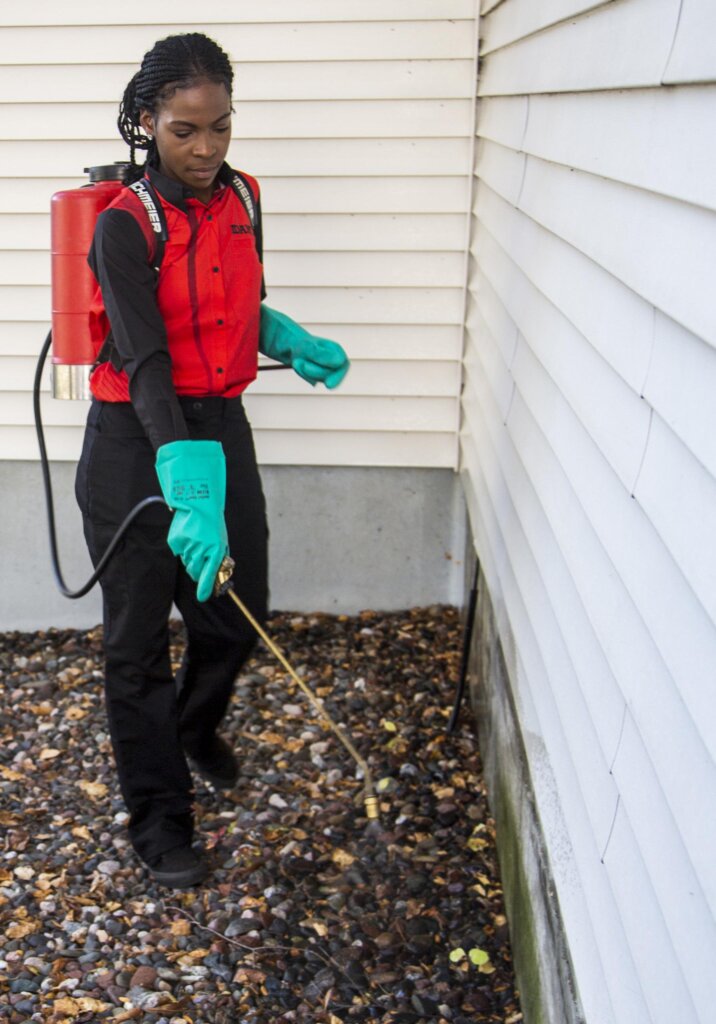Top Quality A1 Pest Control Services Charlotte - Shield Your Home
Top Quality A1 Pest Control Services Charlotte - Shield Your Home
Blog Article
Bed Insect Treatment Breakdown: Contrasting Chemical Vs. Non-Chemical Solutions
In the realm of insect control, specifically when managing the consistent issue of bed pests, the selection in between chemical and non-chemical treatment remedies can be an essential one. Both methods offer unique advantages and downsides, affecting aspects such as efficiency, safety and security factors to consider, and overall price. By taking a look at the nuanced information of each technique, a more clear understanding of which path to seek in dealing with a bed pest problem can be acquired.
Efficiency of Chemical Therapies
Chemical treatments for bed pest invasions have actually been widely identified for their fast and powerful efficiency in eliminating these parasites. When taking into consideration the effectiveness of chemical treatments, it is crucial to recognize that they can supply a quick and complete option to a bed insect issue. Specialist exterminators usually rely upon insecticides to target bed insects at numerous stages of their life cycle, consisting of grownups, nymphs, and eggs. These chemicals typically work by interrupting the bed pests' nerve system, leading to paralysis and ultimate death.
In addition, chemical therapies have the advantage of offering residual impacts, suggesting that they can proceed to get rid of bed pests also after the preliminary application. This residual activity is specifically useful in combating any kind of potential re-infestations. In addition, the fast activity of chemical treatments can bring alleviation to individuals facing severe bed bug infestations, allowing them to regain control of their home promptly.
Safety And Security Worries With Chemical Solutions
When utilizing chemical options for bed bug treatment is making certain the security of residents and the setting,One important facet that requires cautious factor to consider. While chemical therapies can be reliable in getting rid of bed pests, they might position dangers if not managed properly. Among the main safety and security issues with chemical options is the possible harm they can create to human health and wellness. Exposure to certain chemicals used in bed insect therapies can bring about respiratory issues, skin inflammation, or various other adverse reactions, particularly in individuals with pre-existing conditions or level of sensitivities. In addition, inappropriate application or dose of chemical pesticides can result in toxic deposits lingering in the treated area, presenting long-lasting health dangers to passengers.
In addition, the ecological effect of chemical services is one more significant consideration. Some chemicals made use of in bed insect treatments may be dangerous to helpful bugs, wildlife, and communities if they leach right into the dirt or water systems. It A1 pest control services charlotte is important to use chemical treatments judiciously, following safety and security standards, and thinking about much less poisonous options to mitigate these threats and make sure the secure and efficient monitoring of bed insect infestations.
Advantages of Non-Chemical Techniques
Considering the prospective security worries and ecological influence linked with chemical services for bed insect treatment, checking out non-chemical techniques provides a promising option with numerous distinctive advantages. Non-chemical therapies are eco friendly, as they do not contribute to air or water pollution, making them a sustainable choice for pest control.
Furthermore, non-chemical services can be efficient in targeting bed insects, including hard-to-reach locations where chemical treatments might not permeate - A1 exterminator charlotte nc. Approaches such as heat therapy, vacuuming, heavy steam cleaning, and cushion encasements provide extensive removal without the usage of harmful chemicals.
Limitations of Non-Chemical Treatments

Furthermore, non-chemical treatments commonly need several applications to achieve effective removal. This can be taxing and may not constantly guarantee full removal of all bed insects and their eggs, particularly in hidden or hard-to-reach locations.
In addition, the success of non-chemical treatments greatly counts on proper execution and thoroughness, which can be testing for people without professional experience. Inadequate application of non-chemical methods might result in incomplete obliteration, bring about consistent invasions and the need for added therapies.
Consequently, while non-chemical therapies have their advantages, it is vital to recognize these restrictions and consider them when identifying the most effective method for handling bed pest problems.
Cost Comparison: Chemical Vs. Non-Chemical Options
Offered the constraints linked with non-chemical therapies, an important facet to evaluate in the context of bed pest management is the expense contrast between chemical and non-chemical choices. In contrast, non-chemical treatments like heat therapy or heavy steam can be more pricey, with expenses ranging from $1,000 to $6,000 for a whole home. While the initial price of chemical therapies might seem lower, multiple therapies may be called for to fully remove the infestation, possibly raising the overall cost.
Final Thought

Thinking about the possible safety and security problems and ecological influence associated with chemical solutions for bed pest treatment, checking out non-chemical approaches provides an appealing choice with numerous distinct benefits.Given the restrictions associated with non-chemical therapies, an essential facet to examine in the context of bed bug administration is the price contrast in between chemical and non-chemical alternatives. In comparison, non-chemical treatments like heat therapy or vapor can be a lot more costly, with prices ranging from $1,000 to $6,000 for an entire home. While the initial cost of chemical treatments may seem reduced, numerous therapies may be called for to totally eliminate the invasion, possibly increasing the total price.In conclusion, when contrasting chemical and non-chemical bed insect therapy options, it is crucial to take into consideration effectiveness, security, advantages, constraints, and expense.
Report this page